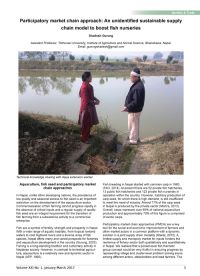In Nepal, low quality and seasonal access to fish seed is an important restriction on the development of the aquaculture sector. Commercialisation of fish farming cannot progress rapidly in the absence of critical inputs and a regular supply of quality fish seed is an integral requirement for the transition of fish farming from a subsistence activity to a commercial enterprise. Participatory market chain approaches are a key tool for the social and economic improvement of farmers and market participants.
FAO, NACA and the Thai Department of Fisheries convened a Regional Consultation Responsible Production and Use of Feed and Feed Ingredients for Sustainable Growth of Aquaculture in Asia-Pacific in Bangkok, 7-9 March 2017. The objective of the consultation was to review the current status of aquaculture feed production and use, demand and supply, sourcing of ingredients, government policies and institutional support, ongoing progress and development gaps. The meeting brought together government and private sector representatives.
Due to the recent increase in aquaculture and the rising demand for marine ingredients for use in pelleted feeds, there is concern that aquaculture is contributing to the over-exploitation of fishing stocks. There is a growing need for aquaculture enterprises to be able to demonstrate responsible practices, including the source of any marine ingredients used in the compound feed. Responsible sourcing can be demonstrated by purchashing ingredients that have been approved under the IFFO RS standard.
Thai Union Feedmill's initiatives to address sustainability issues in aquaculture feed ingredients are discussed in this presentation.
Over the years, there have been two growing sustainability concerns with shrimp supply chain, namely human trafficking and environmental impacts. Solving these two issues can sometime result in conflicting agendas. This summary outlines CPF’s approach and experience in dealing with the two issues. The most difficult challenge in our experience is in building trust and understanding between the stakeholders, including governments and regulators, fisherfolk, commercial fishermen, suppliers and buyers. However, we feel that CPF is now a pioneer in our programs.
